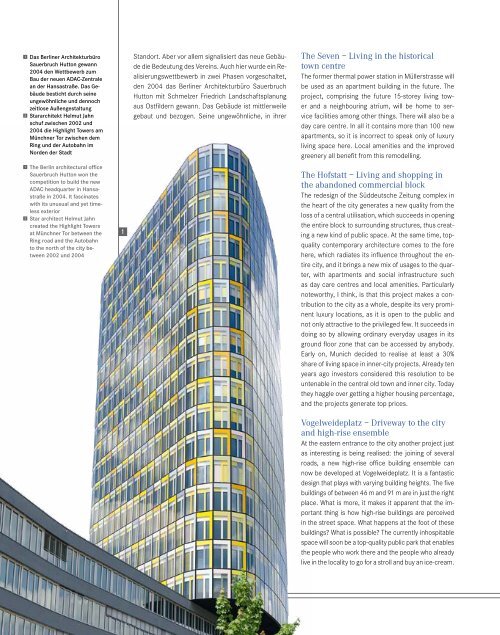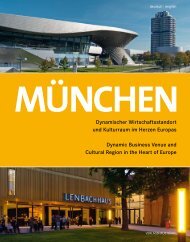München - Dynamischer Wirtschaftsstandort und Kulturraum im Herzen Europas
Create successful ePaper yourself
Turn your PDF publications into a flip-book with our unique Google optimized e-Paper software.
A Das Berliner Architekturbüro<br />
Sauerbruch Hutton gewann<br />
2004 den Wettbewerb zum<br />
Bau der neuen ADAC-Zentrale<br />
an der Hansastraße. Das Gebäude<br />
besticht durch seine<br />
ungewöhnliche <strong>und</strong> dennoch<br />
zeitlose Außengestaltung<br />
S Stararchitekt Helmut Jahn<br />
schuf zwischen 2002 <strong>und</strong><br />
2004 die Highlight Towers am<br />
Münchner Tor zwischen dem<br />
Ring <strong>und</strong> der Autobahn <strong>im</strong><br />
Norden der Stadt<br />
A The Berlin architectural office<br />
Sauerbruch Hutton won the<br />
competition to build the new<br />
ADAC headquarter in Hansastraße<br />
in 2004. It fascinates<br />
with its unusual and yet t<strong>im</strong>eless<br />
exterior<br />
S Star architect Helmut Jahn<br />
created the Highlight Towers<br />
at Münchner Tor between the<br />
Ring road and the Autobahn<br />
to the north of the city between<br />
2002 <strong>und</strong> 2004<br />
Standort. Aber vor allem signalisiert das neue Gebäude<br />
die Bedeutung des Vereins. Auch hier wurde ein Realisierungswettbewerb<br />
in zwei Phasen vorgeschaltet,<br />
den 2004 das Berliner Architekturbüro Sauerbruch<br />
Hutton mit Schmelzer Friedrich Landschaftsplanung<br />
aus Ostfildern gewann. Das Gebäude ist mittlerweile<br />
gebaut <strong>und</strong> bezogen. Seine ungewöhnliche, in ihrer<br />
The Seven – Living in the historical<br />
town centre<br />
The former thermal power station in Müllerstrasse will<br />
be used as an apartment building in the future. The<br />
project, comprising the future 15-storey living tower<br />
and a neighbouring atrium, will be home to service<br />
facilities among other things. There will also be a<br />
day care centre. In all it contains more than 100 new<br />
apartments, so it is incorrect to speak only of luxury<br />
living space here. Local amenities and the <strong>im</strong>proved<br />
greenery all benefit from this remodelling.<br />
The Hofstatt – Living and shopping in<br />
the abandoned commercial block<br />
The redesign of the Süddeutsche Zeitung complex in<br />
the heart of the city generates a new quality from the<br />
loss of a central utilisation, which succeeds in opening<br />
the entire block to surro<strong>und</strong>ing structures, thus creating<br />
a new kind of public space. At the same t<strong>im</strong>e, topquality<br />
contemporary architecture comes to the fore<br />
here, which radiates its influence throughout the entire<br />
city, and it brings a new mix of usages to the quarter,<br />
with apartments and social infrastructure such<br />
as day care centres and local amenities. Particularly<br />
noteworthy, I think, is that this project makes a contribution<br />
to the city as a whole, despite its very prominent<br />
luxury locations, as it is open to the public and<br />
not only attractive to the privileged few. It succeeds in<br />
doing so by allowing ordinary everyday usages in its<br />
gro<strong>und</strong> floor zone that can be accessed by anybody.<br />
Early on, Munich decided to realise at least a 30%<br />
share of living space in inner-city projects. Already ten<br />
years ago investors considered this resolution to be<br />
untenable in the central old town and inner city. Today<br />
they haggle over getting a higher housing percentage,<br />
and the projects generate top prices.<br />
Vogelweideplatz – Driveway to the city<br />
and high-rise ensemble<br />
At the eastern entrance to the city another project just<br />
as interesting is being realised: the joining of several<br />
roads, a new high-rise office building ensemble can<br />
now be developed at Vogelweideplatz. It is a fantastic<br />
design that plays with varying building heights. The five<br />
buildings of between 46 m and 91 m are in just the right<br />
place. What is more, it makes it apparent that the <strong>im</strong>portant<br />
thing is how high-rise buildings are perceived<br />
in the street space. What happens at the foot of these<br />
buildings? What is possible? The currently inhospitable<br />
space will soon be a top-quality public park that enables<br />
the people who work there and the people who already<br />
live in the locality to go for a stroll and buy an ice-cream.<br />
82<br />
Baukultur




